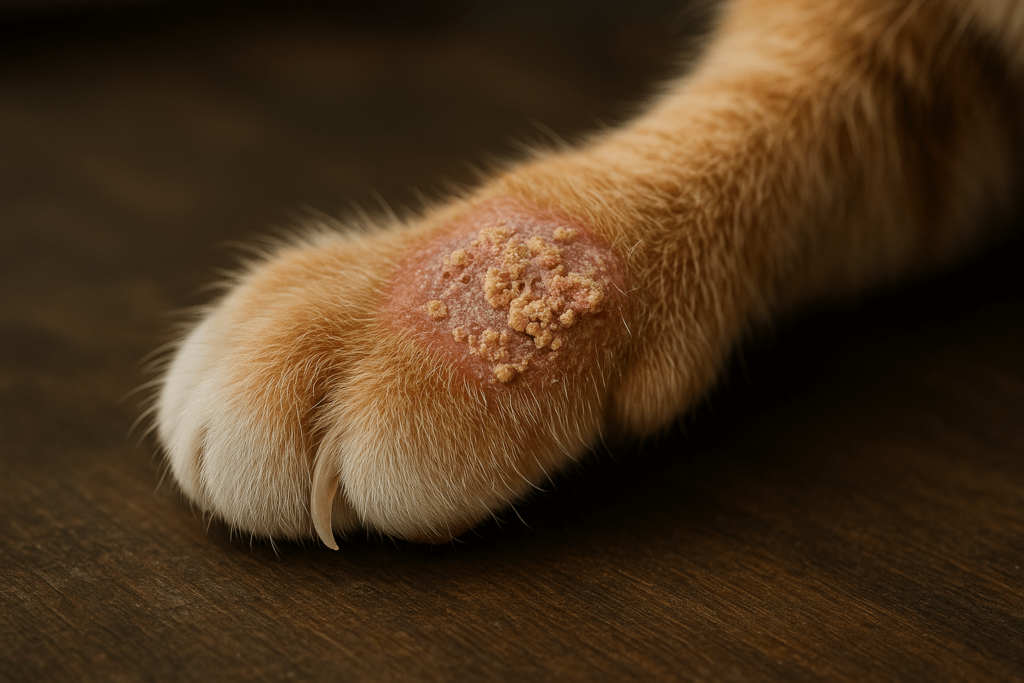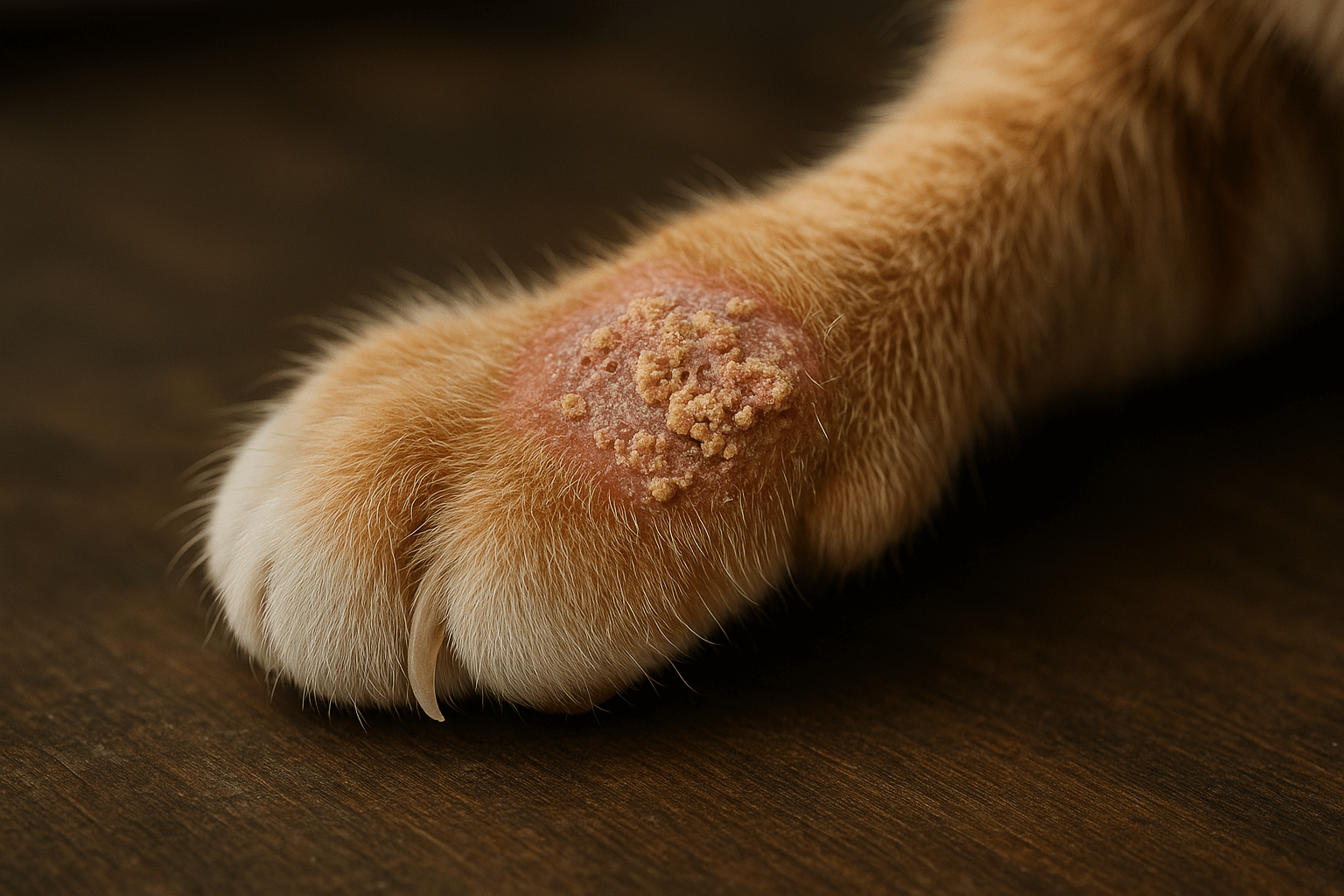Fungus on Cat Paw: Recognizing the Signs and Taking Immediate Action
A fungus on your cat’s paw may seem like a minor issue — but ignoring it can lead to discomfort, spreading infection, or even systemic illness. Unlike human fungal infections, which often appear as athlete’s foot, feline fungal conditions can manifest subtly: redness, hair loss, flaky skin, or an odd odor. If you’ve noticed your cat licking or limping, it’s not just a habit — it’s a signal. Understanding the causes, symptoms, and treatments for fungus on a cat’s paw is critical to protecting your pet’s health and preventing recurrence.
Common Causes of Fungus on a Cat’s Paw
Fungal infections in cats rarely occur in isolation. They’re often the result of environmental exposure, immune compromise, or poor hygiene. Recognizing the root causes helps prevent future outbreaks.
Moisture Trapped Between Toes:
Damp paws from wet litter, puddles, or frequent bathing create the perfect breeding ground for yeast and dermatophytes.Contact with Infected Surfaces:
Shared bedding, carpets, or outdoor areas contaminated with fungal spores (like ringworm) can easily transfer to your cat’s paws.Weakened Immune System:
Older cats, kittens, or those with chronic illness (e.g., FIV, diabetes) are more vulnerable to fungal overgrowth.Poor Grooming Habits:
Cats that groom less due to arthritis, obesity, or stress may fail to clean their paws, allowing fungi to take hold.Antibiotic Use:
Broad-spectrum antibiotics can disrupt natural skin flora, letting opportunistic fungi like Candida thrive.
Fungus doesn’t appear out of nowhere — it thrives where conditions are right. Addressing these triggers is the first step toward healing and prevention.

Symptoms to Watch For: How to Spot Fungus Early
Early detection is the key to stopping a minor paw issue from becoming a chronic problem. Fungal infections often start small but can spread quickly if unnoticed.
Red, Inflamed Skin Between Toes:
Look for persistent redness or swelling that doesn’t improve with cleaning — this is a classic early sign.Hair Loss or Patchy Fur on Paws:
Circular bald spots or thinning fur around the paw pads suggest dermatophyte infections like ringworm.Flaky, Crusty, or Scaly Skin:
Dry, peeling skin resembling dandruff is often fungal, especially if accompanied by itching.Unusual Odor from Paws:
A musty, sour, or yeasty smell coming from your cat’s feet is a strong indicator of yeast overgrowth.Excessive Licking, Biting, or Limping:
If your cat obsessively licks one paw or avoids putting weight on it, they’re likely in discomfort.
Don’t wait for visible sores. Subtle changes in behavior or paw appearance are your cat’s way of asking for help.
Check this guide 👉Cat Paw Injury: Best 7 Expert Tips!
Check this guide 👉Ringworm on Cat Paw Pad: Best 7 Expert Tips!
Check this guide 👉Understanding Cat Paw Cancer: Best 7 Expert Tips!
| Fungal Type | Typical Paw Symptoms |
|---|---|
| Dermatophytosis (Ringworm) | Circular hair loss, scaly patches, redness around paw pads |
| Candidiasis (Yeast) | Musty odor, dark waxy discharge, sticky skin between toes |
| Aspergillosis | Swelling, ulceration, rare but serious — often in immunocompromised cats |
| Mold Exposure | Itching, redness, secondary bacterial infection from constant licking |
| Mixed Infection | Combination of fungal and bacterial signs — most common in chronic cases |
Diagnosis: When to Visit the Veterinarian
While home remedies may seem tempting, fungal infections require accurate diagnosis. Many look like allergies, injuries, or bacterial infections — and treating them incorrectly can worsen the condition.
Veterinary Skin Scraping:
A simple, painless test where the vet scrapes a bit of skin to examine under a microscope for fungal spores.Fungal Culture:
A sample is placed in a special medium to grow and identify the exact fungus — results take 1–3 weeks but are highly accurate.Wood’s Lamp Examination:
Some ringworm strains glow under UV light — a quick screening tool, though not definitive.Biopsy for Persistent Cases:
If the infection doesn’t respond to treatment, a small tissue sample may be needed to rule out cancer or autoimmune disorders.Blood Tests for Underlying Conditions:
Fungal infections often signal immune weakness — testing for FIV, FeLV, or thyroid issues is essential.
Never guess. A misdiagnosed fungal infection can spread to other paws, your home, or even your family.
Treatment Options: From Topicals to Oral Medications
Once diagnosed, treatment depends on the fungus type, severity, and your cat’s overall health. Most cases respond well with consistent care.
Antifungal Shampoos or Dips:
Chlorhexidine or miconazole-based washes are effective for mild cases — use 2–3 times weekly as directed.Topical Creams or Sprays:
Clotrimazole, terbinafine, or miconazole creams applied directly to affected areas daily for 4–6 weeks.Oral Antifungals:
Itraconazole or fluconazole are prescribed for widespread or deep infections — must be given with food to improve absorption.Laser Therapy or Cold Plasma:
Emerging treatments that kill fungi without chemicals — increasingly available in specialty veterinary clinics.Environmental Decontamination:
Wash bedding, vacuum carpets, and disinfect surfaces with diluted bleach (1:10) to prevent reinfection.
Treatment isn’t just about applying medicine — it’s about eliminating the environment where the fungus lives. Consistency over weeks is non-negotiable.
Home Remedies and Natural Support: What Works — and What Doesn’t
While conventional treatment is essential, some natural aids can support healing — but only as supplements, never replacements.
Coconut Oil Application:
Has mild antifungal properties and soothes dry skin — apply sparingly after cleaning the area.Apple Cider Vinegar Rinse (Diluted):
A 50/50 mix with water can help balance skin pH — avoid if skin is broken or raw.Probiotics for Gut Health:
A healthy gut supports immune function — choose feline-specific probiotics to reduce yeast overgrowth.Tea Tree Oil: NEVER USE.
Highly toxic to cats — even small amounts can cause neurological damage or death.Oatmeal Baths:
Soothe itching and reduce inflammation — use unscented, colloidal oatmeal formulated for pets.
Natural remedies can be gentle helpers — but never substitutes for veterinary care. Always consult your vet before trying anything new.
Preventing Future Fungal Infections on Your Cat’s Paws
Prevention is far easier — and cheaper — than treating an active infection. These steps create a fungus-resistant environment.
Dry Paws After Outdoor Walks or Baths:
Wipe paws with a clean, dry towel — especially between the toes — every time they come inside.Keep Litter Boxes Clean and Dry:
Scoop daily, replace litter weekly, and ensure the box is in a well-ventilated area.Avoid Humid Environments:
Use dehumidifiers in damp basements or bathrooms where your cat spends time.Regular Nail Trims:
Short nails reduce the surface area where dirt and moisture can accumulate.Boost Immunity with Balanced Nutrition:
Feed high-quality, protein-rich food with omega-3s and taurine to strengthen skin and immune defenses.
A clean, dry, and well-cared-for cat is a fungus-resistant cat. Prevention isn’t optional — it’s foundational.
When Fungus on Cat Paw Becomes an Emergency
While most cases are treatable, some signs demand immediate veterinary attention.
Paws Swollen, Hot, or Pus-Filled:
Indicates a secondary bacterial infection requiring antibiotics and possible drainage.Cat Refuses to Bear Weight or Whimpers When Touched:
Suggests deep tissue involvement or pain beyond surface fungus.Fever, Lethargy, or Loss of Appetite:
Fungal infections can spread internally — especially in immunocompromised cats.Spreading to Face, Ears, or Belly:
Ringworm and other fungi can disseminate — this is no longer a localized issue.No Improvement After 10 Days of Treatment:
May indicate misdiagnosis, drug resistance, or an underlying disease.
Delaying care in these cases risks permanent damage, systemic illness, or even life-threatening complications.
Frequently Asked Questions About Fungus on Cat Paw
Can humans catch fungus from a cat’s paw?
Yes — ringworm is zoonotic. Wash hands after handling your cat, avoid direct skin contact with infected areas, and disinfect surfaces.
How long does it take to cure a fungal infection on a cat’s paw?
Mild cases take 2–4 weeks; deep or systemic infections may require 8–12 weeks of treatment. Never stop medication early.
Is fungus contagious between cats?
Absolutely. Isolate the infected cat, wash shared items, and treat all cats in the household if one is diagnosed.
Can I use human antifungal cream on my cat?
Never. Human products often contain ingredients toxic to cats, like menthol or camphor. Always use vet-approved formulas.
Why does my cat keep getting fungus on their paws?
Recurring infections usually point to an unresolved cause — damp environment, poor diet, immune disorder, or incomplete treatment.
Embrace Prevention, Not Just Treatment
Fungus on a cat’s paw is not a cosmetic issue — it’s a warning sign. It tells you something in your cat’s environment, health, or routine needs attention. By understanding the causes, recognizing early symptoms, and responding with care and consistency, you don’t just treat an infection — you protect your cat’s long-term well-being. A clean paw is a healthy paw. A dry environment is a safe environment. And a well-informed owner is the best defense against recurring problems. Don’t wait for the next outbreak. Start today — inspect your cat’s paws, clean their space, and give them the healthy foundation they deserve. Your cat’s comfort, and your peace of mind, begin with a single, simple check.
Canned Pumpkin for Cat Diarrhea: Best 7 Expert Tips! Natural remedy to firm stools, soothe upset bellies, and support gut health safely.
Can a Cat Give You Scabies? Best 7 Expert Tips! Discover the truth about feline mites, human skin risks, and how to protect yourself—without panic.
Cat Flea vs Human Flea: Best 7 Expert Tips! Discover the truth about bites, species, and how to eliminate infestations for good.
Weird Cat Behaviors: Best 7 Expert Tips! Discover why cats do strange things—and how to understand, not punish, their instincts for a happier home.





